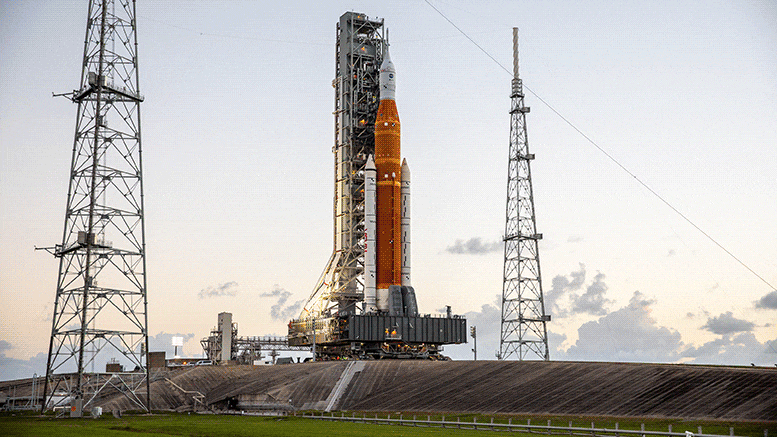

A NASA Space Launch System (SLS) rakétája és az Orion űrszondája a hozzájuk tartozó európai szolgáltatási modullal 2022. november 4-én érkezik meg a NASA Kennedy Űrközpontjában, Floridában, az Egyesült Államokban található Launch Pad 39B-re. Az Artemis I küldetés az SLS és az SLS első tesztje lesz. Az Orion és az Európai Szolgáltatási Egység. Köszönetnyilvánítás: NASA/Kim Shevlet
Az Artemis I mega Moon rakéta az indítóálláson van[{” attribute=””>NASA’s Kennedy Space Center in Florida. This powerful Space Launch System (SLS) rocket is getting ready to launch the Orion spacecraft and its European Service Module. The first opportunity for launch is November 16 at 1:04 a.m. EST/local time (07:04 CET, 06:04 GMT).
Artemis I is the first mission in a large program to send astronauts around and on the Moon sustainably. This uncrewed first launch will see the Orion spacecraft travel to the Moon, enter an elongated orbit around our satellite, and then return to Earth. The Orion spacecraft is powered by the European-built module that supplies electricity, propulsion, fuel, water, and air in addition to keeping the spacecraft operating at the right temperature.

Artemis I mission overview. Orion is NASA’s next spacecraft to send humans into space and is part of the Artemis program. It is designed to send astronauts farther into space than ever before, beyond the Moon and to the lunar Gateway. Credit: ESA–K. Oldenburg
Artemis to the Moon
The European Service Modules are made from components supplied by over 20 companies in ten European Space Agency (ESA) Member States and the United States. As the first European Service Module sits atop the SLS rocket on the launchpad, the second is only 8 km (5 miles) away, as it is currently being integrated with the Orion crew capsule for the first crewed mission – Artemis II. The third and fourth European Service Modules – that will power astronauts to a Moon landing – are in production in Bremen, Germany.

Contributions in Europe for the European Service Module that is powering the Artemis missions around the Moon. Credit:
ESA–K. Oldenburg
The Artemis program is an international endeavor to build a permanent outpost around and on the Moon. Modules for the lunar Gateway are being built in the United States and Europe, with the first European module – International Habitat – in production in Turin, Italy, and set for launch on the fourth Artemis mission alongside the Orion spacecraft.
The first Artemis launch this week is without humans, but three mannequins have been placed in the spacecraft’s seats to conduct scientific research. Fitted with more than 5600 sensors, two mannequins will measure the amount of radiation astronauts could be exposed to in future missions with unprecedented precision. ESA is also including active radiation dosimeters in the Crew Module to get more data on how radiation levels change on a mission to the Moon – building on the leadership developed over decades of radiation research on the International Space Station.

Logo for the first European Service Module (ESM) that is powering NASA’s Orion spacecraft to send humans into space and the Moon as part of the Artemis program. Credit: ESA
Dates
With a November 16 launch, the three-week Artemis I mission would end on December 11 with a splashdown in the Pacific Ocean. The European Service Module detaches from the Orion Crew Module before splashdown and burns up harmlessly in the atmosphere, its job complete after taking Orion to the Moon and back safely.
Backup Artemis I launch dates include November 19. Watch the launch live on ESA Web TV.
Az európai szolgáltatási modullal felszerelt Orion űrszonda messzebbre repül majd a Földtől, mint bármely korábban emberi minősítésű űrhajó. Ez a videó áttekintést nyújt az Artemis első – űrhajósok nélküli – küldetéséről, középpontjában az Európai Űrügynökség európai szolgáltatási moduljával, amely az űrhajót üzemelteti. Az űrszonda a Hold felett repül majd, a holdgravitáció segítségével felgyorsítja a sebességet, és a Holdtól 70 ezer kilométerre, a Földtől csaknem félmillió kilométerre meghajtja magát – messzebbre, mint amennyit ember valaha is megtett, mivel egy távoli retrográd repülésbe pumpálja magát. kering a Hold körül. Visszaútja során az Orion ismét elrepül a Holdon, mielőtt visszatér a Földre. A teljes utazás körülbelül 20 napot vesz igénybe, és azzal ér véget, hogy a víz az ESU nélkül a Csendes-óceánba áramlik – szétválik és ártalmatlanul ég el a légkörben. Köszönet: ESA – Európai Űrügynökség

„Utazási specialista. Tipikus közösségi média tudós. Az állatok barátja mindenhol. Szabadúszó zombinindzsa. Twitter-barát.”





More Stories
A SpaceX Polaris Dawn űrszondájának legénysége a valaha volt legveszélyesebb űrsétára készül
Egy őskori tengeri tehenet evett meg egy krokodil és egy cápa a kövületek szerint
Egyforma dinoszaurusz-lábnyomokat fedeztek fel két kontinensen